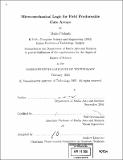| dc.contributor.advisor | Neil Gershenfeld. | en_US |
| dc.contributor.author | Prakash, Manu | en_US |
| dc.contributor.other | Massachusetts Institute of Technology. Dept. of Architecture. Program In Media Arts and Sciences | en_US |
| dc.date.accessioned | 2006-11-07T12:29:15Z | |
| dc.date.available | 2006-11-07T12:29:15Z | |
| dc.date.copyright | 2005 | en_US |
| dc.date.issued | 2005 | en_US |
| dc.identifier.uri | http://hdl.handle.net/1721.1/34486 | |
| dc.description | Thesis (S.M.)--Massachusetts Institute of Technology, School of Architecture and Planning, Program in Media Arts and Sciences, 2005. | en_US |
| dc.description | Includes bibliographical references (leaves 106-110). | en_US |
| dc.description.abstract | A paradigm of micro-mechanical gates for field produceable logic is explored. A desktop manufacturing system is sought after which is capable of printing functional logic devices in the field. A logic scheme which induces non-linearities via geometrical properties is considered. Logic devices in two-phase air-water fluid-dynamic system at micron scales are constructed. A systematic study of non-linearities and relevant force fields in fluid dynamics at low Reynolds Number is undertaken. Viscous forces dominate inertial forces at low Reynolds Number flows at low pressure. Thus devices based on non-linear inertial effects at high Reynolds numbers can not be scaled down to micron-sizes. Bubble microfluidic logic gates are invented to tackle the above problem, thus producing low Reynolds Number logic in Newtonian fluids. Various devices including AND/OR gates, NOT gate, nonvolatile bistable memory, shift registers and ON/OFF flow valves, based on this new scheme of bubble bubble interaction in microfluidic devices to induce non-linearity, are designed and characterized. On-chip bubble generators and annihilators are used for encoding and destroying information in bubble logic devices. | en_US |
| dc.description.abstract | (cont.) Applications of the above described logic devices as a flow control strategy for droplet based Lab-on-chip devices is explored. A simple to construct in-situ pressure sensor based on the principle of compressibility of an air bubble in microfluidic devices is invented. A scheme of controlled bubble/droplet movement in shift registers via pulsating pressure fields for precise temporal control of start of microfluidic reactions is proposed. Excimer laser micro-machining of boro-silicate glass is developed to direct write 3D microfluidic structures. Laser ablation process using a ArF based 193nm laser for machining is characterized using laser confocal microscopy techniques. Single bubble cavitation induced by laser pulses is developed as a process for writing micro-bubbles at precise locations in microfluidic channels. | en_US |
| dc.description.statementofresponsibility | by Manu Prakash. | en_US |
| dc.format.extent | 110 leaves | en_US |
| dc.format.extent | 25989774 bytes | |
| dc.format.extent | 25989567 bytes | |
| dc.format.mimetype | application/pdf | |
| dc.format.mimetype | application/pdf | |
| dc.language.iso | eng | en_US |
| dc.publisher | Massachusetts Institute of Technology | en_US |
| dc.rights | M.I.T. theses are protected by copyright. They may be viewed from this source for any purpose, but reproduction or distribution in any format is prohibited without written permission. See provided URL for inquiries about permission. | en_US |
| dc.rights.uri | http://dspace.mit.edu/handle/1721.1/7582 | |
| dc.subject | Architecture. Program In Media Arts and Sciences | en_US |
| dc.title | Micro-mechanical logic for field produceable gate arrays | en_US |
| dc.type | Thesis | en_US |
| dc.description.degree | S.M. | en_US |
| dc.contributor.department | Program in Media Arts and Sciences (Massachusetts Institute of Technology) | |
| dc.identifier.oclc | 70786701 | en_US |
